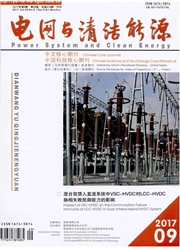

 中文摘要:
中文摘要:
针对目前电力系统中由于非线性负荷的使用以及某些可再生能源发电系统的接人导致的谐波问题,首先介绍了电力系统仿真分析软件ETAP的主要功能和特点,然后在ETAP中建立算例模型并对其进行谐波仿真分析,同时也在另外两款仿真分析软件EMTDC和PSASP上对算例模型建模并导出谐波分析图谱,通过对照进一步说明ETAP在谐波分析中的优缺点。然后在原算例模型的基础上修改其中的高压网络短路容量、减少变压器投运数量、改变变压器阻抗以及增加电动机和无源负荷容量等参数,将仿真所得数据同理论计算结果对比,并分析这些参数的变化给系统并联谐振点的位置和幅值,以及谐波畸变程度造成的影响。结果表明,由于ETAP软件在谐波仿真方面的卓越性能,在面临大规模系统的规划和电能质量评估方面的问题时,利用ETAP进行预先的谐波仿真分析可以辅助建立有效的方案降低系统中的谐波畸变程度,并利用谐振分析可以有效地避开谐振位置.从而提高电力系统的电能质量。
 英文摘要:
英文摘要:
This paper addresses the harmonic problems caused by nonlinear loads and accession of the renewable energy system.First, the main functions and features of the power system analysis software ETAP are introduced. The model of the example is then established with this software. The harmonic simulation analysis is conducted on the model; meanwhile, the same simulation is made on EMTDC and PSASP, other two power system analysis softwares,and the export data is obtained for comparison so as to gain a further understanding of the advantages and disadvantages of the ETAP in Harmonic Analysis.Then changes are made on the original model such as revising the short-circuit capacity of the high voltage network, reducing the number of transformers put into operation, changing the transformer's resistance and increasing the motor load capacity. Comparisons are made between the simulation results and those obtained by theoretical calculations. The impacts caused by changes of the parameters of the power system equipment on the frequency and amplitude of the system parallel resonance as well as the harmonic distortion are analyzed. Because of the superior performance, the ETAP software can be used as a powerful tool to make the prior harmonic simulation to reduce the degree of harmonic distortion in the system, and the resonance analysis can help to avoid the resonance position to improve the power quality when we make planning of large-sized power system and address problems in the power energy assessment.
 同期刊论文项目
同期刊论文项目
 同项目期刊论文
同项目期刊论文
 期刊信息
期刊信息
